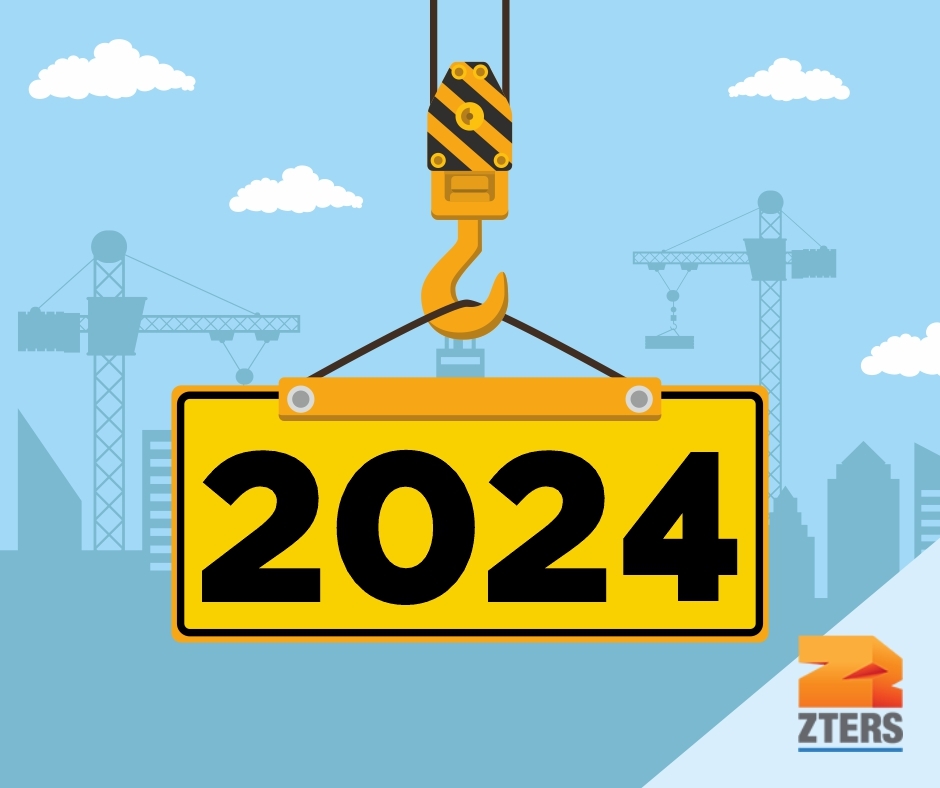With rapid advancements in Artificial Intelligence (AI), Virtual Reality (VR), and other technologies, it seems that every industry is poised for significant transformations going into 2024. The construction industry stands at the forefront of a lot of these innovations, yet the 2024 construction outlook extends far beyond tech-related advancements.
2023 construction industry trends were defined by green building initiatives, more AI applications, and even an increase in remote work. Much of this holds true for 2024, but there’s even more on the horizon.
Evidently, many sectors took a heavy hit from inflation in 2023. Costs for materials skyrocketed while the demand for construction workers far exceeded the worker pool. Consequently, we saw a slowdown in construction starts. Because the construction industry is often used as an indicator for the economic landscape, economists keep a close watch.
So what’s ahead? Here’s a non-comprehensive snapshot of the construction outlook for 2024.
A Growing Number of Starts
According to Engineering News-Record:
The overall value of construction starts is expected to rise 7% in 2024, following a 1% increase in 2023, according to the Dodge forecast. The 2023 boost will bring total starts value to $1.124 trillion, with $1.206 trillion forecast for 2024.
Experts are optimistic yet cautious about growth considering that geopolitical and macroeconomic factors can be unpredictable to say the least. Additionally, the construction industry is far from a monolith. While some segments of the industry like highway/bridge construction may rise, others like residential building may dip.
Continued Labor Shortage
A predominant challenge casting a shadow over the 2024 construction outlook is the persistent issue of labor shortages. As highlighted by the Bureau of Labor Statistics (BLS), the demand for skilled construction labor continues to outpace the available workforce.
Experts speculate that this is a result of a gap in highly skilled labor, an aging demographic, and insufficient recruiting. With vocational training incentives and other initiatives, it’s possible that this gap could narrow. For the time being however, this shortage can have a definite impact on project starts and timelines.
Greater Tech Integrations
Each year, the construction industry gets more and more digitized. Maybe you’re tired of hearing about how AI and other smart technologies are revolutionizing just about every industry. But there’s no denying that construction technology is transforming the way projects are managed — from start to finish.
From cloud computing and collaboration technologies to construction robots and drones, there have never been more ways for construction professionals to communicate with one another, improve time management, automate processes, and make data-driven decisions.
Even at ZTERS, we’re leveraging advanced tools like smart waste technologies and on-site augmented reality to make your life easier.
Increased Focus on Risk Management
It comes as no surprise that with all the uncertainties and potential pitfalls, risk management is vital for the longevity and profitability of construction companies. The popular phrase “hope is not a strategy” rings especially true here. It’s ill-advised to rely solely on an original plan, timeline, or order of operations. While it’s wonderful when things go according to plan, that’s often not the case.
When construction companies invest time, money, and energy into risk management, it can really save them in the event of major obstacles. From labor shortages to delayed supply chains to the volatile costs of building materials, being prepared for a curveball can be a make or break matter.
Stricter Sustainability Regulations
Sustainability has become a guiding principle for many construction endeavors, rightfully so. Evolving regulations are helping to ensure that sustainability isn’t just a buzzword, but an actual practice.
Starting a Construction Project?
Kick off your jobsite rental with an account manager.
Some upcoming changes to California’s building codes—which will go into effect mid-2024— reveal what’s on the horizon for many other states across the country:
In addition to embodied carbon calculations, the new building code changes will also introduce a range of measures to reduce the environmental impact of construction materials. These measures include:
- Requiring the use of low-carbon materials, such as recycled content and bio-based materials
- Implementing procurement policies that prioritize environmentally responsible sourcing
- Encouraging the adoption of prefabrication and modular construction techniques to minimize on-site waste and emissions (Source)
To begin preparing for these environmental requirements, prioritize sustainability in every decision. Scrambling to adhere to regulations can cause major disruptions down the line. You can read more about sustainable waste practices on our blog.
Are You Ready for the New Year?
At the end of the day, industry forecasts are exactly that — forecasts. Though they’re often grounded in observable trends and historical data, they’re not set in stone. That’s why being aware and adaptable is important.
At ZTERS, we like to keep a pulse on the industry given how closely we work with construction professionals. We’re always here to talk more about how we can support your project.
Let 2024 be a year of more convenience and more reliability. ZTERS has your back on all things construction site services. We’re here to help streamline your projects with construction dumpster rentals, portable toilets, temporary fencing, and more. We’re just one call away and that’s something worth a cheers!

